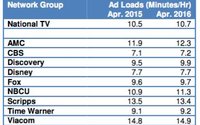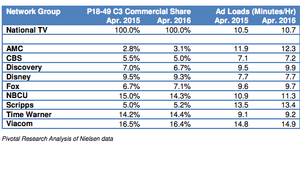National TV Ad Loads Grow
- by Wayne Friedman , May 17, 2016
 National TV’s hourly advertising commercial
time continues to rise.
National TV’s hourly advertising commercial
time continues to rise. In April 2016, analysis of Nielsen data from Pivotal Research Group shows that advertising loads grew nearly 2% to 10.7 minutes per hour over April 2015 for 18-49 viewers in the Nielsen C3 metric, the average minute commercial rating plus three days of time-shifted viewing.
Brian Wieser, senior analyst at Pivotal, said: “Network groups increased commercial loads to support growth in inventory for sale above and beyond changes in ratings.” His analysis says there was 602.1 billion national TV commercial impressions.
Although Viacom has said it has been looking to reduce commercial ad loads at some of its networks overall, Viacom networks average more commercial gross ratings points than any other network group. This came to an average of 14.9 minutes of national advertising per hour in April of this year versus 14.8 in April 2015. Viacom also has the greatest share of C3 commercial time among 18-49 viewers -- at 16.4%.
advertisement
advertisement
On a percentage basis, Discovery Communications, NBCUniversal and AMC Networks were three TV network groups showing the greatest upward change. Discovery rose 4.2% to 9.9 minutes per hour, while NBC increased 3.7% to 11.3 minutes per hour, and AMC rose 3.3% to 12.3 minutes.
Scripps Networks Interactive was the only network group to show a decline in national commercial ad load -- down a tick to 13.4 minutes per hour in April of this year versus 13.5 minutes per hour in April 2015. Scripps has been one of the few network groups to show recent overall ratings growth.
CBS was at 7.2 minutes per hour in national commercial advertising time (up from 7.1 minutes); Fox at 9.7 minutes (up from 9.6 minutes); Time Warner at 9.2 minutes (growing from 9.1 minutes).
Disney networks were flat at 7.7 minutes.



Judging by these numbers, it appears that most of the increases are taking place in cable and---probably---not in primetime. I wonder if Weiser would supply finer breakdowns that would clarify the situation? He probably has the info, but wont. Anyway, it can't hurt to ask.